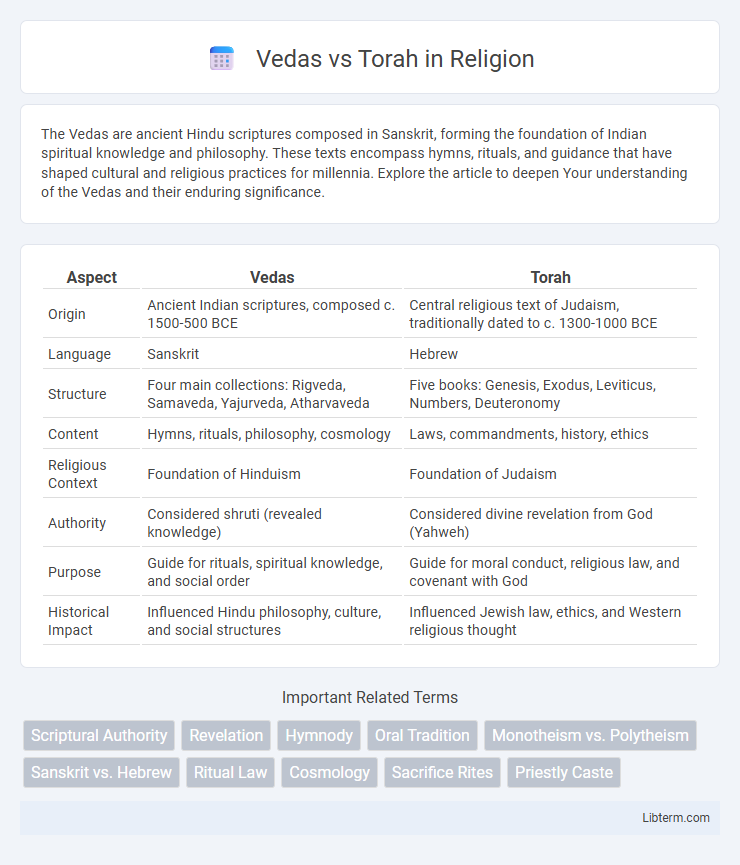The Vedas are ancient Hindu scriptures composed in Sanskrit, forming the foundation of Indian spiritual knowledge and philosophy. These texts encompass hymns, rituals, and guidance that have shaped cultural and religious practices for millennia. Explore the article to deepen Your understanding of the Vedas and their enduring significance.
Table of Comparison
| Aspect | Vedas | Torah |
|---|---|---|
| Origin | Ancient Indian scriptures, composed c. 1500-500 BCE | Central religious text of Judaism, traditionally dated to c. 1300-1000 BCE |
| Language | Sanskrit | Hebrew |
| Structure | Four main collections: Rigveda, Samaveda, Yajurveda, Atharvaveda | Five books: Genesis, Exodus, Leviticus, Numbers, Deuteronomy |
| Content | Hymns, rituals, philosophy, cosmology | Laws, commandments, history, ethics |
| Religious Context | Foundation of Hinduism | Foundation of Judaism |
| Authority | Considered shruti (revealed knowledge) | Considered divine revelation from God (Yahweh) |
| Purpose | Guide for rituals, spiritual knowledge, and social order | Guide for moral conduct, religious law, and covenant with God |
| Historical Impact | Influenced Hindu philosophy, culture, and social structures | Influenced Jewish law, ethics, and Western religious thought |
Introduction to the Vedas and Torah
The Vedas, ancient sacred texts of Hinduism composed in Sanskrit around 1500-500 BCE, consist of four collections: Rigveda, Samaveda, Yajurveda, and Atharvaveda, encompassing hymns, rituals, and spiritual knowledge. The Torah, central to Judaism, is composed of the five books of Moses--Genesis, Exodus, Leviticus, Numbers, and Deuteronomy--written primarily in Hebrew and serving as the foundational scripture outlining laws, history, and ethics. Both texts are revered as divine revelations that guide religious practice, morality, and cultural identity in their respective traditions.
Historical Origins and Development
The Vedas, originating around 1500 BCE in ancient India, represent the oldest layer of Sanskrit literature and form the foundation of Hindu religious knowledge and practice. The Torah, traditionally dated to the first millennium BCE, is the central reference of the Jewish religious tradition, comprising the first five books of the Hebrew Bible and representing the covenant between God and the Israelites. Both texts emerged within distinct cultural and historical frameworks, with the Vedas rooted in Indo-Aryan oral traditions and the Torah in the ancient Near Eastern context, influencing their respective religious, legal, and ethical developments.
Language and Literary Structure
The Vedas are composed in ancient Sanskrit, characterized by rich poetic meters and hymns organized into four main texts: Rigveda, Samaveda, Yajurveda, and Atharvaveda. The Torah, written primarily in Biblical Hebrew, features a narrative prose structure with legal codes, historical accounts, and genealogies comprising the first five books of the Hebrew Bible. While the Vedic texts emphasize ritual chants and philosophical hymns, the Torah presents a structured compilation of laws and covenantal narratives fundamental to Jewish tradition.
Core Beliefs and Philosophical Themes
The Vedas emphasize dharma, karma, and the pursuit of moksha, focusing on the cyclical nature of life, cosmic order (Rta), and the unity of Atman (self) with Brahman (ultimate reality). The Torah centers on monotheism, covenant, and divine law (Halakha), underscoring obedience to God (Yahweh), ethical living, and historical narrative as guiding principles. Both texts shape distinct worldviews: the Vedas propose an eternal, transcendental reality and spiritual liberation, while the Torah establishes a temporal, ethical framework anchored in a personal God and communal identity.
Concepts of God and Divinity
The Vedas present a diverse and multifaceted concept of God, emphasizing multiple deities representing natural forces and an ultimate, formless Brahman as the supreme reality. The Torah centers on a singular, omnipotent, and personal God, Yahweh, who is the sole creator and ruler of the universe with a defined moral and covenantal relationship with humanity. These foundational texts reflect distinct theological frameworks: the Vedas with their polytheistic and philosophical aspects, and the Torah with its strict monotheism and ethical monotheism.
Rituals, Practices, and Worship
The Vedas emphasize intricate yajnas (fire rituals) and mantra chanting as core elements of worship, focusing on maintaining cosmic order through precise ceremonial practices. The Torah prescribes mitzvot (commandments) including ritual purity, Sabbath observance, and sacrifices in the ancient Temple, emphasizing covenantal obedience and ethical monotheism. While Vedic rituals center on sacrificial ceremonies and hymns to multiple deities, Torah worship integrates prayer, Torah reading, and communal rituals rooted in Hebrew law and tradition.
Social and Ethical Teachings
The Vedas emphasize dharma, righteousness, and the interconnectedness of all beings, promoting social duties and ethical conduct rooted in karma and societal order. The Torah outlines laws and commandments centered on justice, compassion, and communal responsibility, framing ethical behavior through covenantal obligations between God and the people of Israel. Both scriptures shape social norms and moral values, guiding individual actions and collective harmony within their respective cultural contexts.
Transmission and Preservation Methods
The Vedas were transmitted primarily through oral tradition, using precise phonetic techniques like mantra chanting and memorization to ensure accuracy across generations. The Torah, preserved in written form, relies on meticulously maintained manuscripts and scribal traditions to safeguard its text integrity. Both emphasize continuity and fidelity, with the Vedas prioritizing auditory transmission and the Torah focusing on written documentation.
Influence on Subsequent Religions
The Vedas profoundly shaped Hinduism, inspiring concepts of dharma, karma, and reincarnation that influenced Buddhism, Jainism, and Sikhism. The Torah serves as the foundational text for Judaism, embedding laws and ethical monotheism that deeply impacted Christianity and Islam. Both scriptures continue to guide millions, their theological principles underpinning diverse religious traditions worldwide.
Comparative Analysis and Modern Relevance
The Vedas, ancient Hindu scriptures composed in Sanskrit, emphasize cosmic order, rituals, and hymns, while the Torah, central to Judaism, contains laws, ethical teachings, and historical narratives in Hebrew. Both texts shape their respective religious practices and moral frameworks, but the Vedas influence diverse Hindu philosophies and rituals, whereas the Torah forms the foundation of Jewish law and identity. In modern contexts, the Vedas inform spiritual practices and yoga traditions globally, whereas the Torah continues to guide Jewish cultural continuity and legal systems within Israel and Jewish communities worldwide.
Vedas Infographic

 libterm.com
libterm.com